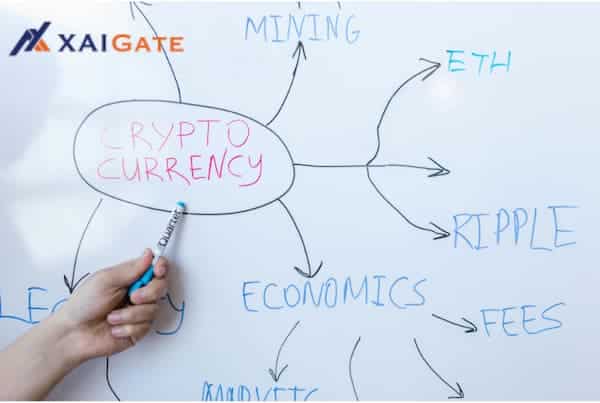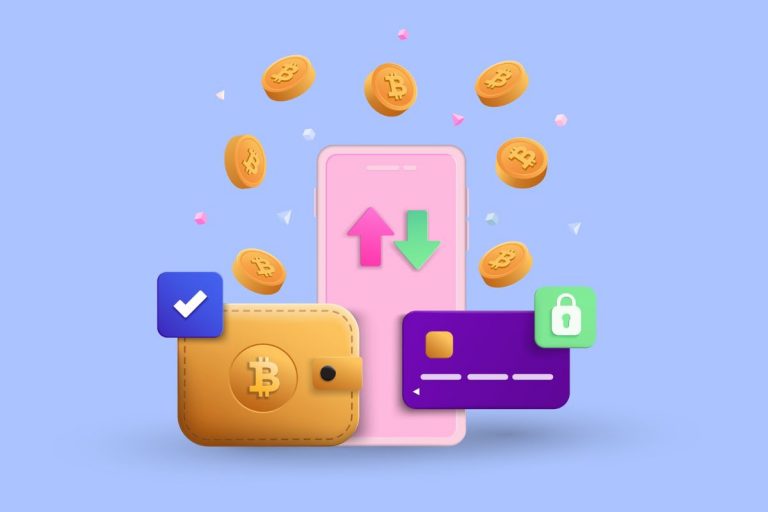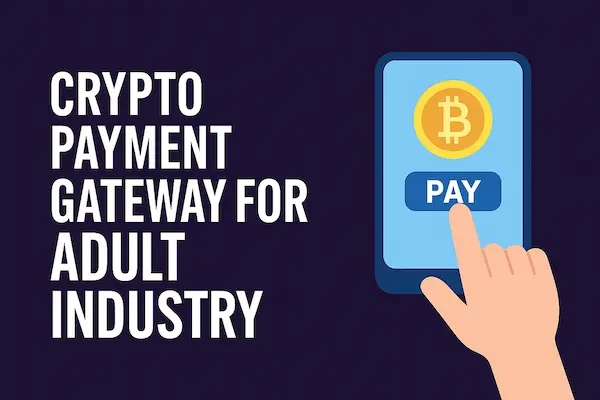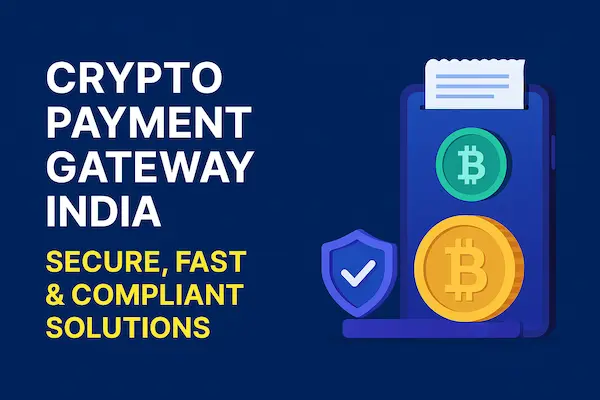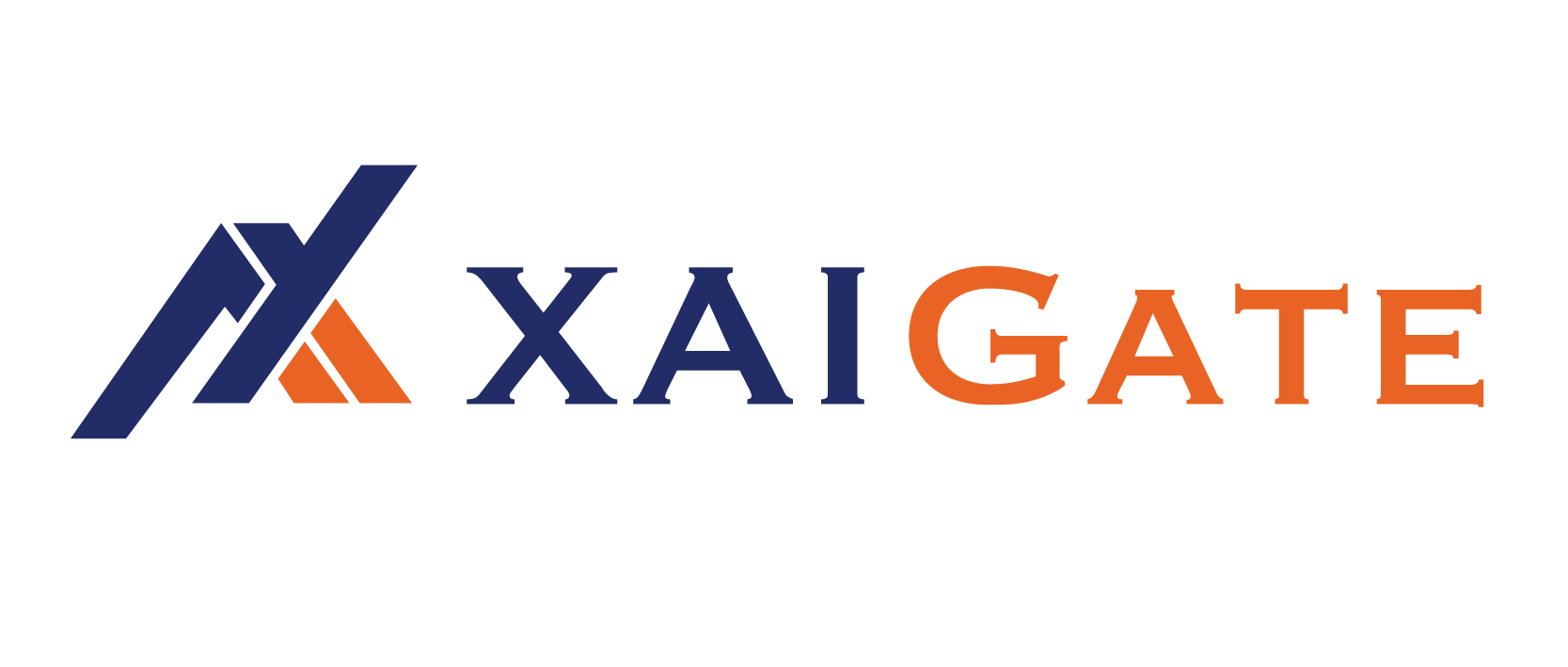Singapore is already a strong base for online retail, but cross-border payments still create friction: card declines, high FX fees and slow bank transfers. A Crypto Payment Gateway Singapore E-commerce setup offers another rail for moving value, letting customers pay in coins or stablecoins while you still settle cleanly in SGD. Before deciding if it fits your store, it helps to see what a gateway actually does, who really benefits, and when it is better to wait.
Contents
- 1 1. Crypto Payment Gateway Singapore E-commerce – Quick Answer For Busy Store Owners
- 2 2. What Is a Crypto Payment Gateway in the Singapore E-commerce Context
- 3 3. Regulatory Basics – How Crypto Payment Gateways Fit Into Singapore’s Rules
- 4 4. Why Use a Crypto Payment Gateway for Singapore E-commerce
- 5 5. Key Benefits of a Crypto Payment Gateway Singapore E-commerce Setup
- 6 6. Choosing the Right Crypto Payment Gateway for Your Online Store
- 7 7. Integration Models – How To Add A Crypto Gateway To Your E-commerce Stack
- 8 8. UX and Conversion – Designing a Crypto-Friendly Checkout
- 9 9. Managing Risks – Volatility, Fraud and Operational Issues
- 10 10. Singapore E-commerce Use Cases – From SMEs to Regional Brands
- 11 11. Data, Reporting and Analytics for Crypto Payment Gateway Singapore E-commerce
- 12 12. Implementation Roadmap – 30, 60 and 90 Days to Go Live
- 13 FAQs – Crypto Payment Gateway Singapore E-commerce
- 14 Conclusion – Turning Plans into Real Online Sales
1. Crypto Payment Gateway Singapore E-commerce – Quick Answer For Busy Store Owners
Most store owners just want to know one thing: is this worth it? In short, a Crypto Payment Gateway Singapore E-commerce setup lets customers pay in coins or stablecoins while a specialist partner handles wallets, rates, on-chain confirmation and settlement into your SGD account. You stay the merchant, not a mini exchange.
1. What a crypto payment gateway does in one paragraph
The gateway sits between your checkout and the blockchain. When a buyer selects crypto, it shows a wallet address or QR code, locks the price for a few minutes, waits for confirmation and then tells your cart the payment is complete. Later, the provider batches those payments and sends you funds in SGD or in tokens. In a well-designed Crypto Payment Gateway Singapore E-commerce flow, your team mostly sees normal orders and clear payout reports.
2. Who actually needs a crypto payment gateway and who does not
A gateway makes the most sense if you sell to overseas customers, ship digital goods, run subscriptions for a global audience or serve Web3-native users who already hold stablecoins. If your buyers are almost all local, volumes are modest and current payment methods work well, a Crypto Payment Gateway Singapore E-commerce project can wait until demand is clearer.
Quick snapshot – when crypto payments are worth prioritising
Table 1 – When crypto payments deserve attention
| Store profile | Crypto priority | Why |
|---|---|---|
| Cross-border digital goods / SaaS | High | Many foreign buyers, card issues, strong fit for stablecoins |
| Regional or global niche brand | Medium–High | Mixed PSP results, good test bed for a focused crypto pilot |
| Local Singapore SME | Low–Medium | Mostly SGD buyers, watch demand before adding new methods |
| Very small / early-stage store | Low | Fix product and traffic first, revisit gateways after scaling |
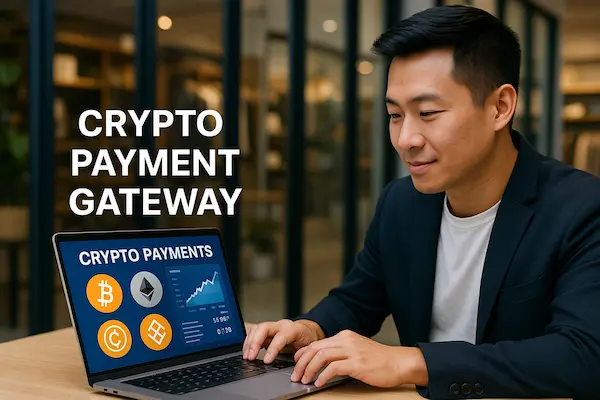
2. What Is a Crypto Payment Gateway in the Singapore E-commerce Context
In a Crypto Payment Gateway Singapore E-commerce setup, the gateway is simply a payments layer. It plugs into your cart, talks to customer wallets, connects to blockchains and then returns clean “paid / failed / refunded” states and SGD payouts your finance team can work with.
1. From customer wallet to your bank account – the basic flow
At checkout the buyer picks “Pay with crypto”. Your store sends the order to the gateway, which shows a QR code or address, locks a rate for a few minutes and waits for confirmation. When the transaction is final, the gateway flags the order as paid and later includes it in a payout to your bank or to a wallet you choose. You never deal directly with nodes or raw blockchain data.
2. Core components of a modern crypto payment gateway stack
Most gateways offer plugins or a simple API, a pricing engine to quote crypto amounts, a settlement module to batch and convert payments, and a dashboard for reports and exports. Behind that sit wallets, custody, monitoring and support processes. A solid stack makes a Crypto Payment Gateway Singapore E-commerce integration feel like working with any other mature PSP.
3. Types of gateways – custodial, non-custodial and instant fiat settlement
Custodial gateways receive and hold customer tokens before converting and paying you. Non-custodial models try to minimise how long they hold assets and can route more directly to wallets you own. Some services focus on instant conversion to SGD so you never carry price risk. Knowing which approach fits your store narrows the list of suitable crypto payment gateway partners in Singapore.
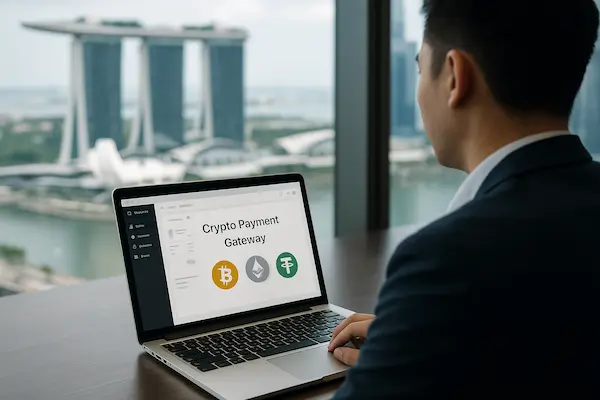
3. Regulatory Basics – How Crypto Payment Gateways Fit Into Singapore’s Rules
You do not need to master regulation to use a Crypto Payment Gateway Singapore E-commerce setup, but you should know who is regulated and for what. Singapore focuses on activities: who moves money or tokens for others, and at what scale.
1. Payment Services Act overview and digital payment token services
Under the Payment Services Act, many crypto activities sit in the “digital payment token” bucket. Gateways and exchanges usually fall here because they help users pay, hold or transfer tokens and may need a payment services licence. Most online stores do not, as long as they use licensed providers and do not run their own exchange or pooled wallets.
2. Merchants versus licensed providers – who does what
In a clean model, the gateway handles licensing, AML, custody and technology risk. It owns the wallet logic, the blockchain connections and most of the compliance workload. The merchant focuses on products, pricing, customer communication and keeping good records. The Crypto Payment Gateway Singapore E-commerce setup works best when you stay clearly in the merchant lane and let the provider run the rails.
3. Quick legal checklist before you launch
Before going live, have one short meeting with legal and finance and answer a few basics:
- Who is the legal entity behind the gateway and where is it based?
- What licence does it hold and which services are covered?
- How are funds and tokens stored, and in whose name?
- How are refunds handled and in which currency or token?
Putting these answers on a single page gives you a simple snapshot of your Crypto Payment Gateway Singapore E-commerce arrangement and shows banks, auditors and investors that the project is controlled, not experimental.

4. Why Use a Crypto Payment Gateway for Singapore E-commerce
If cards and bank transfers already work, why add anything else? For many stores, the answer is simple: a Crypto Payment Gateway Singapore E-commerce setup reaches buyers you currently lose, especially overseas customers who live in crypto or hate FX fees. When done right, it becomes one more serious rail for moving money, not a gimmick.
1. New customer segments and higher international conversion
There is now a growing group of shoppers who hold most of their online spending power in coins or stablecoins. They may be gamers, Web3 users, freelancers paid in crypto or buyers in markets with weak card penetration. If your checkout only offers cards and local bank methods, they often bounce. Adding a crypto lane through a gateway gives these users a familiar way to pay, which can lift conversion without changing your core offer.
2. Faster cross-border settlement and less FX friction
Traditional cross-border payments can be slow, noisy and expensive. Cards bring chargeback risk, wire transfers take days and FX spreads eat into margin. With a Crypto Payment Gateway Singapore E-commerce integration, overseas buyers can pay in tokens while the gateway handles conversion and settlement to SGD. You get clearer timing on when funds arrive, fewer surprises on fees and a simpler story for cash flow planning, especially if you deal with many small international orders.
3. Lower chargeback exposure and clearer payment finality
Card chargebacks can turn a good month into a headache, especially for digital goods and subscriptions. Crypto payments do not work the same way: once confirmed, they are much harder to reverse. That does not remove your duty to handle refunds fairly, but it does shift control back to your policies instead of leaving you exposed to arbitrary chargeback claims. With a sensible refund process and a Crypto Payment Gateway Singapore E-commerce flow that logs each step, you gain clearer finality on payments while still keeping room to look after honest customers when something goes wrong.
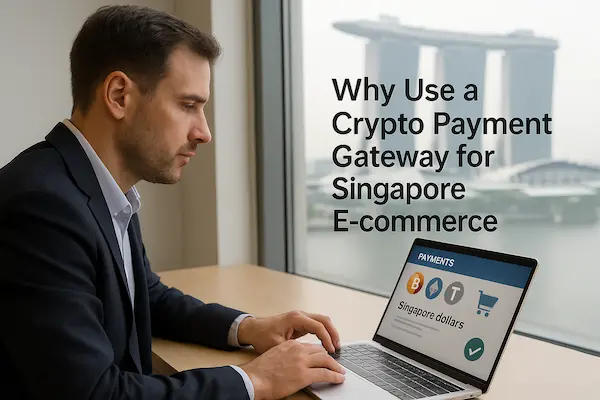
5. Key Benefits of a Crypto Payment Gateway Singapore E-commerce Setup
A good Crypto Payment Gateway Singapore E-commerce setup is not just about adding another logo at checkout. It can quietly solve real problems around reach, cost and how your brand is perceived by modern buyers.
1. Reducing payment friction in hard-to-reach markets
In some countries cards fail often, local methods are confusing and bank transfers are slow. Letting customers pay from their own wallets through a gateway gives them a familiar route to complete orders, while you still see a simple “paid” status in your system.
2. Improving margins through better fee and FX structures
Card and cross-border fees can stack up fast. Crypto rails have a different mix of network, gateway and FX costs, which can be cheaper on some routes. By tracking real costs per method, you can steer certain corridors through the option that quietly protects your margins.
3. Strengthening brand perception with a modern checkout
For Web3-heavy audiences, how they can pay says a lot about how you think. Offering a calm, clearly explained crypto option alongside cards shows you are current but not reckless. It positions your store as practical and forward-looking, rather than chasing hype.

6. Choosing the Right Crypto Payment Gateway for Your Online Store
Once you know why you want crypto, the next step is picking the right partner. The wrong provider can turn a promising Crypto Payment Gateway Singapore E-commerce plan into support headaches and awkward questions from your bank. The right one should feel like any other professional PSP: clear, stable and boring in the best possible way.
1. Must have features for Singapore e-commerce merchants
Start with basics: does the gateway support the coins and stablecoins your customers actually use, and can it settle cleanly into SGD on a schedule that fits your cash flow. Look for ready-made plugins for your platform, a simple API for custom work, a solid merchant dashboard, exportable reports and clear tools for refunds and partial credits. If a demo cannot show you a full payment flow plus the matching payout report in a few minutes, keep looking.
2. Compliance, licensing and reputation checks that actually matter
Next, check the boring but crucial parts. Who is the legal entity behind the gateway, where is it based and what licences does it hold. Do those licences actually cover digital payment token services or just marketing. Search for past incidents, downtime, security issues and how they were handled. In a serious Crypto Payment Gateway Singapore E-commerce setup, you want a partner that is transparent about controls, audits and risk, not just about new features.
3. Pricing models, hidden costs and impact on your margins
Finally, look at money. Some gateways charge a simple percentage fee, others mix spreads, fixed fees and withdrawal charges. Ask for worked examples using your real average order value and main markets. Check how often payouts are made, who absorbs network fees and what happens when exchange rates move sharply. A gateway that looks cheap on headline fees but locks you into slow settlement or wide spreads can hurt more than it helps. The best choice is the one that keeps your Crypto Payment Gateway Singapore E-commerce channel profitable even after every hidden cost is counted.
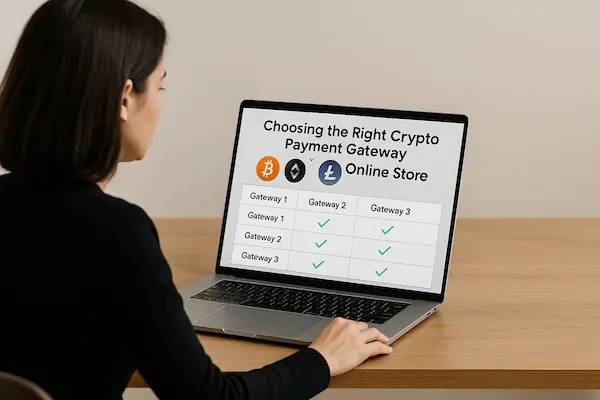
7. Integration Models – How To Add A Crypto Gateway To Your E-commerce Stack
A good integration should feel like a normal PSP, not a rebuild of your whole site. Most Crypto Payment Gateway Singapore E-commerce projects fit into one of three models.
1. Plug-in integrations for Shopify, WooCommerce and hosted carts
If you use a mainstream platform, start with an official or well-supported plugin. Connect your store, add API keys, pick supported coins or stablecoins and run a few test orders. This is usually the fastest way to launch a low-risk pilot with minimal developer time.
2. API-based setups for custom stores and marketplaces
Custom or headless builds often need a direct API. Your team calls the gateway for payment requests, listens for callbacks and maps them to your own order states. This takes more effort but gives full control over UX, routing and how crypto data flows into your back office.
3. Hybrid flows that combine card, bank and crypto
Most stores keep cards and local bank methods, then add crypto as one more button in the same step. Your existing PSP handles traditional payments, while the gateway handles wallets and tokens. Reporting should still roll up cleanly so finance sees one coherent payment picture, not three separate systems.
8. UX and Conversion – Designing a Crypto-Friendly Checkout
A Crypto Payment Gateway Singapore E-commerce setup only works if customers actually use it. Keep the crypto option visible, simple and low-stress, not hidden or confusing.
1. Where and how to place the crypto option
Show crypto on the same payment step as cards and bank methods. Use clear labels like “Pay with crypto (via secure gateway)” instead of a wall of coin logos. On the review screen, display total in SGD, the estimated crypto amount and a short note that the rate is locked for a few minutes.
2. Trust-building copy, not hype
Use calm, practical lines such as “We never see your private keys” or “No extra FX fees for supported coins”. Avoid hype about “moon” or quick profits. The goal is to make crypto feel like one more safe method in your Crypto Payment Gateway Singapore E-commerce mix.
3. Mobile-friendly QR and wallet flow
Most buyers will pay from their phones. Make QR codes big and clear, add a visible timer and show a simple 1–2–3 guide (open wallet, scan, confirm). Always offer a copyable address and an easy way to restart if the window expires so the flow feels robust, not fragile.
9. Managing Risks – Volatility, Fraud and Operational Issues
No payment method is risk free. A Crypto Payment Gateway Singapore E-commerce setup trades some familiar card issues (chargebacks, acquirers blocking markets) for a different mix of volatility, fraud and operational details. The goal is not zero risk, but risk you understand and can manage.
1. Handling volatility with pricing windows and auto-conversion
The main concern with tokens is price swings. A simple way to control this is to use short pricing windows and automatic conversion. The gateway locks a rate for a few minutes, shows the required token amount and, once paid, converts to SGD on a clear schedule. You still set prices in your normal currency; crypto is only the rail that carries value. With the right settings, your Crypto Payment Gateway Singapore E-commerce channel behaves more like a fixed-price card sale than a speculative trade.
2. Fraud, abuse and refund patterns to watch
Fraud still exists, but it looks different. Stolen wallets are rarer than stolen card numbers, yet abuse can show up as reselling digital goods, testing stolen identities on low-ticket orders or pressuring support for off-policy refunds. Keep the same discipline you use elsewhere: basic velocity checks, simple rules for high-risk SKUs and clear limits on how and when refunds are given. Crypto is harder to reverse on-chain, so your policies and support scripts carry more weight than card chargeback rules.
3. Playbooks for disputes, refunds and customer support
Before launch, write two or three short playbooks: what support should do if a customer claims they paid but your system shows nothing, how to handle overpayments or underpayments, and when to offer refunds in fiat, tokens or store credit. Make sure these steps are visible to finance and approved by leadership. When a real case arrives, your team can follow a script instead of improvising. Over time, that discipline turns your Crypto Payment Gateway Singapore E-commerce channel from an experiment into a normal, predictable part of your operations.
10. Singapore E-commerce Use Cases – From SMEs to Regional Brands
A Crypto Payment Gateway Singapore E-commerce setup does not look the same for every business. The logic is similar, but the reasons, risks and scale change a lot between a small local shop and a regional brand selling across time zones.
1. Local SME stores adding a simple crypto payment option
A small fashion, electronics or lifestyle store mainly serving Singapore can start very light. Crypto appears as one more method at checkout, routed through a plugin and settled in SGD. Volumes may be modest, but it sends a clear message to Web3-heavy customers and gives the team hands-on experience without changing core operations. For many SMEs this is the right entry point: limited scope, clear reporting and a tight feedback loop with customers.
2. Cross-border brands targeting APAC and global crypto users
Regional or global brands with strong overseas traffic often see the biggest uplift. Here, a Crypto Payment Gateway Singapore E-commerce integration can reduce failed payments from certain countries, speed up settlement and make high-value digital or subscription orders easier to complete. These merchants usually combine card, bank and crypto in one checkout, steer specific corridors into crypto when it performs better, and track results by market to prove the value of the new rail.
3. High-ticket B2B e-commerce and stablecoin invoicing
For B2B platforms selling software, equipment or services, settlement and FX risk often matter more than front-end conversion. Invoices can be large, customers are spread across regions and bank transfers are slow. Stablecoin payments through a gateway let buyers pay from their own wallets while the seller receives predictable value on a clear timetable. With the right contracts and accounting treatment, this kind of Crypto Payment Gateway Singapore E-commerce use case turns crypto from a curiosity into a practical working capital tool.
11. Data, Reporting and Analytics for Crypto Payment Gateway Singapore E-commerce
If you cannot see it, you cannot improve it. A Crypto Payment Gateway Singapore E-commerce setup should give you clear numbers, not just a new button at checkout. Think of it as one more data source you plug into your existing reporting stack.
1. What metrics you should track beyond basic volume
Start with conversion rate by payment method and by country: how often crypto succeeds versus cards or bank transfers. Add average order value, refund rate, dispute rate and time from payment to payout. Over a few weeks you will see where the gateway really helps and where it is just noise. Tracking wallet types or token mix (for example, stablecoins vs volatile coins) also shows you how “serious” the usage is.
2. Using payment data to improve pricing, UX and product mix
Once you have clean data, use it. If certain markets convert far better on crypto, consider localised pricing or targeted campaigns there. If crypto buyers concentrate on specific SKUs or plans, build offers around those. Watch where users drop out of the crypto flow and adjust copy, timers or instructions. Treated this way, your Crypto Payment Gateway Singapore E-commerce channel becomes a testing ground for smarter pricing and UX decisions, not just a technical add-on.
3. Sharing the right reporting with finance, tax and audit teams
Finance will care about reconciliation and timing; tax teams about jurisdiction and documentation; auditors about controls and consistency. Give them regular exports that tie each payout to orders, fees and FX rates, plus a short note on how the gateway works and who your counterparties are. If these reports line up cleanly with your general ledger and bank statements, your crypto rail will feel like any other well-governed payment channel when review season comes around.
12. Implementation Roadmap – 30, 60 and 90 Days to Go Live
A Crypto Payment Gateway Singapore E-commerce rollout can stay lean if you phase it. Think in three short sprints instead of one big project.
1. Days 1–30 – understand and decide
- Map your current payment methods and key markets.
- Define the main goal: better conversion, cheaper FX, new segments, or B2B invoices.
- Shortlist 2–3 gateways that support SGD and your platform.
- Check licences, pricing and basic risk.
By day 30 you should know whether to proceed and which provider is your first choice.
2. Days 31–60 – connect and test
- Sign the contract and set clear scope, fees and refund rules.
- Install the plugin or wire the API in a test environment.
- Configure coins/stablecoins, rate lock window and payout schedule.
- Run full test flows: success, failure, timeout, refund.
End of this phase: your team is comfortable using the tool internally.
3. Days 61–90 – soft launch and review
- Switch on crypto for a limited set of products or markets.
- Track conversion, errors and support tickets closely.
- Adjust wording, placement and limits based on real data.
- Decide whether to scale, pause or refine the Crypto Payment Gateway Singapore E-commerce channel.
After 90 days you should have real numbers, not guesses, to decide how big this rail should become in your overall payment strategy.
FAQs – Crypto Payment Gateway Singapore E-commerce
Most teams ask the same questions before turning on a Crypto Payment Gateway Singapore E-commerce option. These short FAQs give quick, practical answers you can scan in a minute.
1. Do I need a licence to add a crypto payment gateway to my store?
Usually no. In most cases the licensed provider runs the payment rails, and you remain a merchant using its service, not a regulated digital payment token business.
2. How does a crypto gateway settle money into my SGD bank account?
Customers pay in coins or stablecoins, the gateway aggregates those payments and converts them on a set schedule, then sends you a payout in SGD with a report you can reconcile.
3. Which coins or stablecoins should I support for online sales?
Start narrow: one or two major stablecoins and, if relevant, a small set of well-known coins. Fewer options keep UX simple and reduce support and risk.
4. How do refunds work with crypto payments?
Most gateways let you refund in fiat, in tokens or as store credit. Decide your default approach, write it into your terms and train support so customers get consistent answers.
5. Will a crypto payment option upset my bank or existing PSP?
It can if they learn about it late. Share a short note explaining that a licensed partner handles crypto rails, you settle mostly in SGD, and volumes will start small as a pilot.
6. Is a crypto payment gateway safe for small Shopify or WooCommerce stores?
Yes, if you use a reputable provider, keep limits sensible and treat it like any other payment rail. Start with a plugin, tight settings and a clear rollback plan.
7. Does adding crypto mean I must hold tokens on my balance sheet?
Not if you choose instant or frequent fiat settlement. You can keep all accounting in SGD and treat crypto purely as a transport layer for value.
8. How do I know if the pilot is working?
Track conversion by payment method, error rates, refunds and net margin after all fees. If the Crypto Payment Gateway Singapore E-commerce channel brings in new revenue on healthy economics, expand it; if not, adjust or switch it off.Extended thinking
Conclusion – Turning Plans into Real Online Sales
A Crypto Payment Gateway Singapore E-commerce setup only makes sense if it brings in new revenue on healthy economics. The good news is you do not need to rebuild your stack or change your whole business model. You need a clear goal, the right partner and a disciplined pilot that you can explain to your bank, your board and your team.
Quick summary for decision-makers
| Area | What matters most |
|---|---|
| Strategy | Use crypto to fix real problems: cross-border conversion, FX cost, B2B settlement |
| Partners | Work with licensed, reputable gateways that support SGD and your platform |
| Integration | Start with plugins or simple APIs; keep the flow hybrid with cards and bank |
| Risk | Use rate locks, auto-conversion and clear refund rules to control volatility |
| Operations | Train support and finance; keep clean reports and simple reconciliation |
| Measurement | Track conversion, fees and net margin by method, market and product |
If you can answer “yes, we do this” down the right-hand side, your Crypto Payment Gateway Singapore E-commerce channel is on solid ground.
What to do next
Over the next 90 days, you can move from idea to real numbers:
- Map and decide – Document your current payment flows and main markets, then write one paragraph on why you want crypto at all.
- Shortlist and sanity-check – Pick two or three gateways, check licences, pricing and platform support, and choose one for a pilot.
- Integrate and train – Connect via plugin or API, run test transactions, and brief support and finance on basic scripts and reports.
- Launch a controlled pilot – Enable crypto for selected products or markets and watch conversion, errors and refunds closely.
- Review and scale – If the numbers work, expand gradually; if not, adjust settings or switch it off and keep the lessons.
Handled this way, a Crypto Payment Gateway Singapore E-commerce setup becomes just another serious rail in your payment mix: measurable, supervised and fully aligned with the rest of your business, rather than a risky side experiment you hope nobody questions.
For daily updates, subscribe to XAIGATE’s blog!
We may also be found on GitHub, and X (@mxaigate)!


